Numerical Investigation of Mechanical Performance and Micro-Structure Failure of Polymer-Fiber Reinforced Sand
Abstract
:1. Introduction
2. Materials and Methods
2.1. Materials
2.1.1. Organic Polymer
2.1.2. Polypropylene Fiber
2.1.3. Sand
2.2. Laboratory Test Scheme
2.3. Numerical Test Scheme
2.4. Verification
3. Results
3.1. Breakage of Inter-Particle Bonding
3.2. Microcracking Response
3.3. Energy Response
4. Discussion
4.1. SEM Observations
4.2. Different Processing of Sample Microfracture Mode
4.2.1. Influence of Polymer on Microfracture Mode
4.2.2. Effect of Fiber on Microdamage Mode
4.3. Polymer and Fiber Coupling Mechanism
5. Conclusions
- (1)
- The OPS and PF treatments improved the integrity of the sand, while a differential damage response was observed under varying test conditions. The bonding effect of the polymer resulted in multiple cracking paths and rough broken surfaces. The fibers served as anchors, stimulating lateral bulging and rugged failure of the specimens during loading.
- (2)
- The maintenance of the mechanical strength in modified sand depends remarkably on the interparticle bonding state, which is affected by the force-chain network and crack distribution. The initial specimen cracking was concentrated and divided into the elastic, slow extension, rapid expansion, and residual stages. The increased homogeneous force transfer induced by the polymer membrane results in a greater range of particle motion and crack initiation. The fibers adhere to and confine the surrounding particles, resulting in arching force chains and dispersed/bending cracking.
- (3)
- The external energy input to the modified sand is transformed into strain energy, which consists of elastic and bonding energies and breaking energy, which is the driving force for bonding deterioration. The energy evolution can be summarized in the compaction, elastic deformation, plastic failure, release, and residual stages. Polymer and fiber treatments increase energy capacity and improve release, thereby influencing deformation damage.
- (4)
- Organic polymer and fiber mixed improvement of sand adopts a combination of chemical and physical improvement methods. The fiber was added to the sand to reinforce, whereas the organic polymer was added to the sand to wrap and fill. Organic polymers, fibers, and sand particles form an effective interlocking structure that enhances the integrity and mechanical properties of sand. This achievement provides a research basis for the application of numerical simulation technology in sand–soil composite improvements.
Author Contributions
Funding
Institutional Review Board Statement
Data Availability Statement
Conflicts of Interest
References
- Orense, R.P.; Kiyota, T.; Yamada, S.; Cubrinovski, M.; Hosono, Y.; Okamura, M.; Yasuda, S. Comparison of liquefaction Features observed during the 2010 and 2011 Canterbury earthquakes. Seism. Res. Lett. 2011, 82, 905–918. [Google Scholar] [CrossRef]
- Feizi, Z.; Ayoubi, S.; Mosaddeghi, M.R.; Besalatpour, A.A.; Zeraatpisheh, M.; Rodrigo-Comino, J. A wind tunnel experiment to investigate the effect of polyvinyl acetate, biochar, and bentonite on wind erosion control. Arch. Agron. Soil Sci. 2019, 65, 1049–1062. [Google Scholar] [CrossRef]
- Ateş, A. The Effect of Polymer-Cement Stabilization on the Unconfined Compressive Strength of Liquefiable Soils. Int. J. Polym. Sci. 2013, 2013, 356214. [Google Scholar] [CrossRef]
- Zorluer, I.; Demirbas, A. Use of marble dust and fly ash in stabilization of base material. Sci. Eng. Compos. Mater. 2013, 20, 47–55. [Google Scholar] [CrossRef]
- Jones, B.R.; Jacobsz, S.W.; van Rooy, J.L. A qualitative model study on the effect of geosynthetic foundation reinforcement in sand overlying very soft clay. J. S. Afr. Inst. Civ. Eng. 2016, 58, 25–34. [Google Scholar] [CrossRef]
- Yang, Q.-W.; Pei, X.-J.; Huang, R.-Q. Impact of polymer mixtures on the stabilization and erosion control of silty sand slope. J. Mt. Sci. 2019, 16, 470–485. [Google Scholar] [CrossRef]
- Cabalar, A.; Wiszniewski, M.; Skutnik, Z. Effects of Xanthan Gum Biopolymer on the Permeability, Odometer, Unconfined Compressive and Triaxial Shear Behavior of a Sand. Soil Mech. Found. Eng. 2017, 54, 356–361. [Google Scholar] [CrossRef]
- Zhang, H.; Wang, G.; Du, J.; Pei, X.; Du, P.; Zhou, L. Effects of several polymeric materials on the improvement of the sandy soil under rainfall simulation. J. Environ. Manag. 2023, 345, 118847. [Google Scholar] [CrossRef]
- Liu, J.; Feng, Q.; Wang, Y.; Bai, Y.; Wei, J.; Song, Z. The Effect of Polymer-Fiber Stabilization on the Unconfined Compressive Strength and Shear Strength of Sand. Adv. Mater. Sci. Eng. 2017, 2017, 2370763. [Google Scholar] [CrossRef]
- Liu, J.; Qi, X.; Zhang, D.; Feng, Q.; Wang, Y.; Kanungo, D.P. Study on the Permeability Characteristics of Polyurethane Soil Stabilizer Reinforced Sand. Adv. Mater. Sci. Eng. 2017, 2017, 5240186. [Google Scholar] [CrossRef]
- Liu, J.; Chen, Z.; Song, Z.; Bai, Y.; Qian, W.; Wei, J.; Kanungo, D.P. Tensile Behavior of Polyurethane Organic Polymer and Polypropylene Fiber-Reinforced Sand. Polymers 2018, 10, 499. [Google Scholar] [CrossRef] [PubMed]
- Zhang, J.; Liu, J.; Cheng, Y.; Jiang, T.; Sun, D.; Saberian, M. Water-retention behaviour and microscopic analysis of two biopolymer-improved sandy soils. Constr. Build. Mater. 2023, 403, 133202. [Google Scholar] [CrossRef]
- Che, W.; Liu, J.; Hao, S.; Ren, J.; Song, Z.; Bu, F. Application of colloid-sand coating treated by a hydrophilic polysaccharide biopolymer material for topsoil stability control. Geoderma 2022, 424, 115994. [Google Scholar] [CrossRef]
- Che, W.; Liu, J.; Li, H.; He, C.; Bai, Y.; Song, Z.; Wang, Y.; Qian, W.; Chen, Z. Experimental investigation and discrete element method simulation on mechanical properties and failure mechanism of polymer-stabilized sand. Bull. Eng. Geol. Environ. 2022, 81, 1–22. [Google Scholar] [CrossRef]
- Nozoe, S.; Kaneko, K.; Hashizume, Y. Optimum mixture design of granular materials reinforced by short fiber. J. AIP Conf. Proc. 2013, 1542, 305. [Google Scholar] [CrossRef]
- Karakan, E.; Eskişar, T.; Altun, S. The Liquefaction Behavior of Poorly Graded Sands Reinforced with Fibers. Adv. Civ. Eng. 2018, 2018, 4738628. [Google Scholar] [CrossRef]
- Jairaj, C.; Kumar, M.T.P. Strength Behavior of Sand Reinforced with Treated Sisal Fibers. Ground Improv. Tech. 2021, 2021, 23–32. [Google Scholar] [CrossRef]
- Xu, D.-S.; Yan, J.-M.; Liu, Q. Behavior of discrete fiber-reinforced sandy soil in large-scale simple shear tests. Geosynth. Int. 2021, 28, 598–608. [Google Scholar] [CrossRef]
- Kantha, K.R.; Deepthi, K. An Experimental Study on Stabilisation of Loose Soil by Using Sisal Fiber. Int. J. Trend Sci. Res. Dev. 2019, 3, 659–662. [Google Scholar] [CrossRef]
- Estabragh, A.R.; Bordbar, A.T.; Javadi, A.A. A Study on the Mechanical Behavior of a Fiber-Clay Composite with Natural Fiber. Geotech. Geol. Eng. 2012, 31, 501–510. [Google Scholar] [CrossRef]
- Szypcio, Z.; Dołżyk-Szypcio, K.; Chmielewska, I. Stress–Dilatancy Behaviourof Fibre-Reinforced Sand. Materials 2023, 16, 609. [Google Scholar] [CrossRef]
- Sen, B.; Saha, R. Experimental and numerical investigation of mechanical strength characteristics of natural fiber retrofitted rammed earth walls. Geotext. Geomembr. 2022, 50, 970–993. [Google Scholar] [CrossRef]
- Ganiev, J.; Nakano, M.; Sakai, T. Numerical analysis of drained compression behavior of fiber-reinforced sand based on a soil skeleton structure concept. Comput. Geotech. 2022, 148, 104789. [Google Scholar] [CrossRef]
- Venkatachalam, G.; Shankar, A.G.; Raghav, D.; Kiran, R.S.; Mahesh, B.; Kumar, K. Flexural analysis of palm fiber reinforced hybrid polymer matrix composite. IOP Conf. Ser. Mater. Sci. Eng. 2015, 87, 012036. [Google Scholar] [CrossRef]
- Ayeldeen, M.; Kitazume, M. Using fiber and liquid polymer to improve the behaviour of cement-stabilized soft clay. Geotext. Geomembr. 2017, 45, 592–602. [Google Scholar] [CrossRef]
- Rivera-Gómez, C.; Galán-Marín, C.; Bradley, F. Analysis of the Influence of the Fiber Type in Polymer Matrix/Fiber Bond Using Natural Organic Polymer Stabilizer. Polymers 2014, 6, 977–994. [Google Scholar] [CrossRef]
- Bai, Y.; Liu, J.; Song, Z.; Chen, Z.; Jiang, C.; Lan, X.; Shi, X.; Bu, F.; Kanungo, D.P. Unconfined Compressive Properties of Composite Sand Stabilized with Organic Polymers and Natural Fibers. Polymers 2019, 11, 1576. [Google Scholar] [CrossRef]
- Yuan, B.; Li, Z.; Chen, Y.; Ni, H.; Zhao, Z.; Chen, W.; Zhao, J. Mechanical and microstructural properties of recycling granite residual soil reinforced with glass fiber and liquid-modified polyvinyl alcohol polymer. Chemosphere 2022, 286, 131652. [Google Scholar] [CrossRef]
- Zhao, Y.; Xiao, Z.; Fan, C.; Shen, W.; Wang, Q.; Liu, P. Comparative mechanical behaviors of four fiber-reinforced sand cemented by microbially induced carbonate precipitation. Bull. Eng. Geol. Environ. 2020, 79, 3075–3086. [Google Scholar] [CrossRef]
- ASTM Standard D2166; Standard Test Method for Unconfined Compressive Strength of Cohesive Soil. ASTM West: Conshohocken, PA, USA, 2016.
- ASTM Standard D3080; Standard Test Method for Direct Shear Test of Soils Under Consolidated Drained Conditions (With-drawn 2020). ASTM West: Conshohocken, PA, USA, 2020.




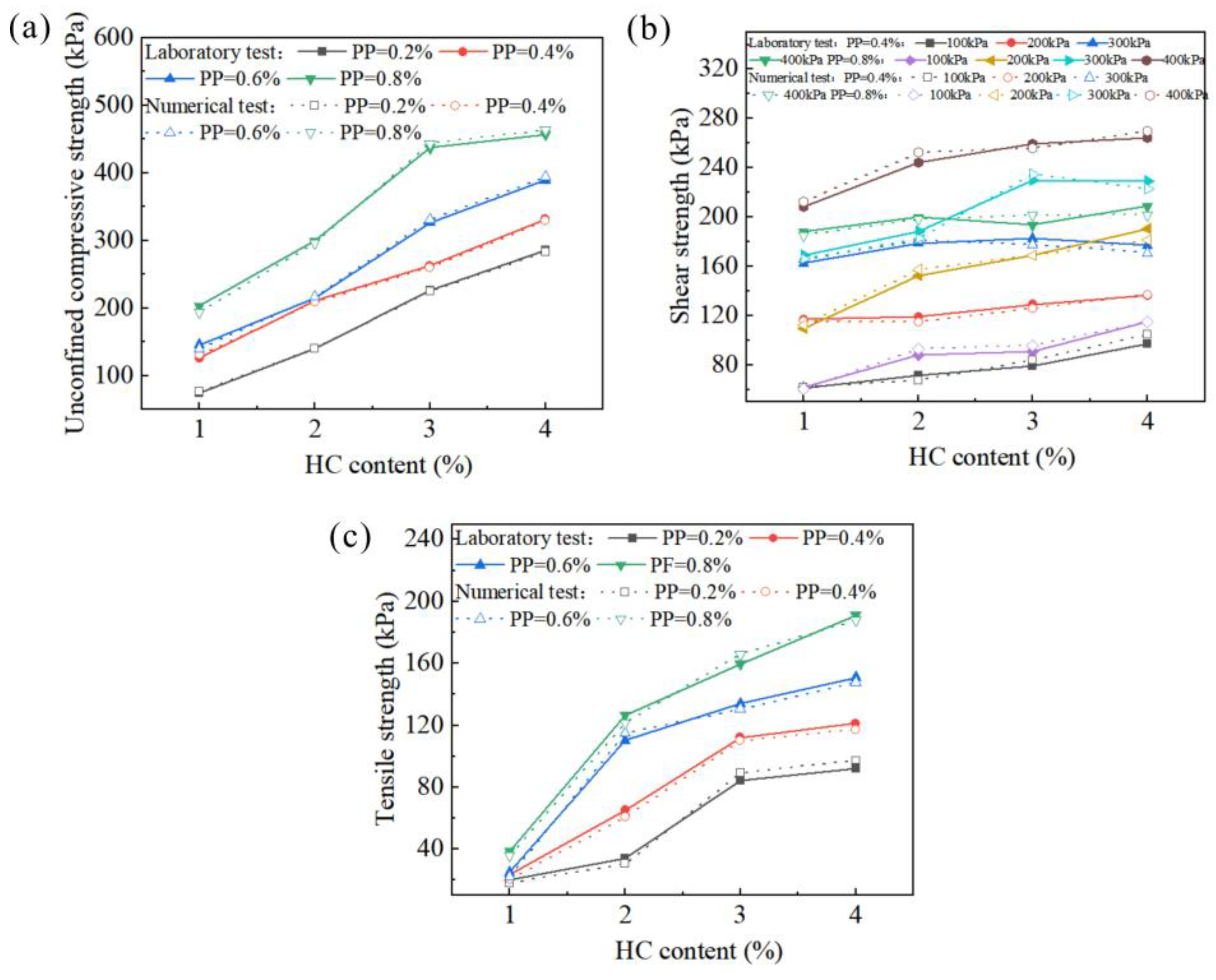
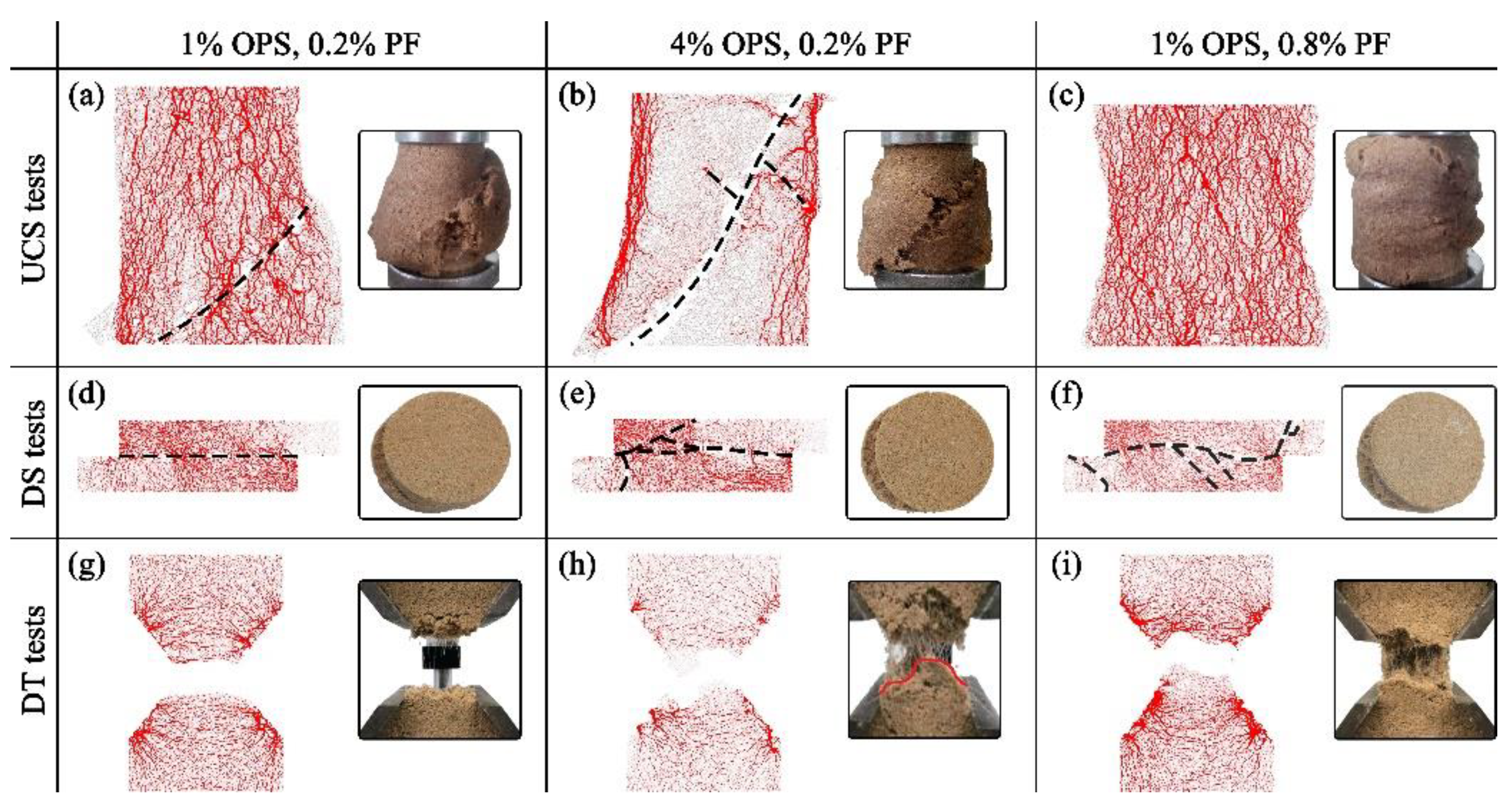


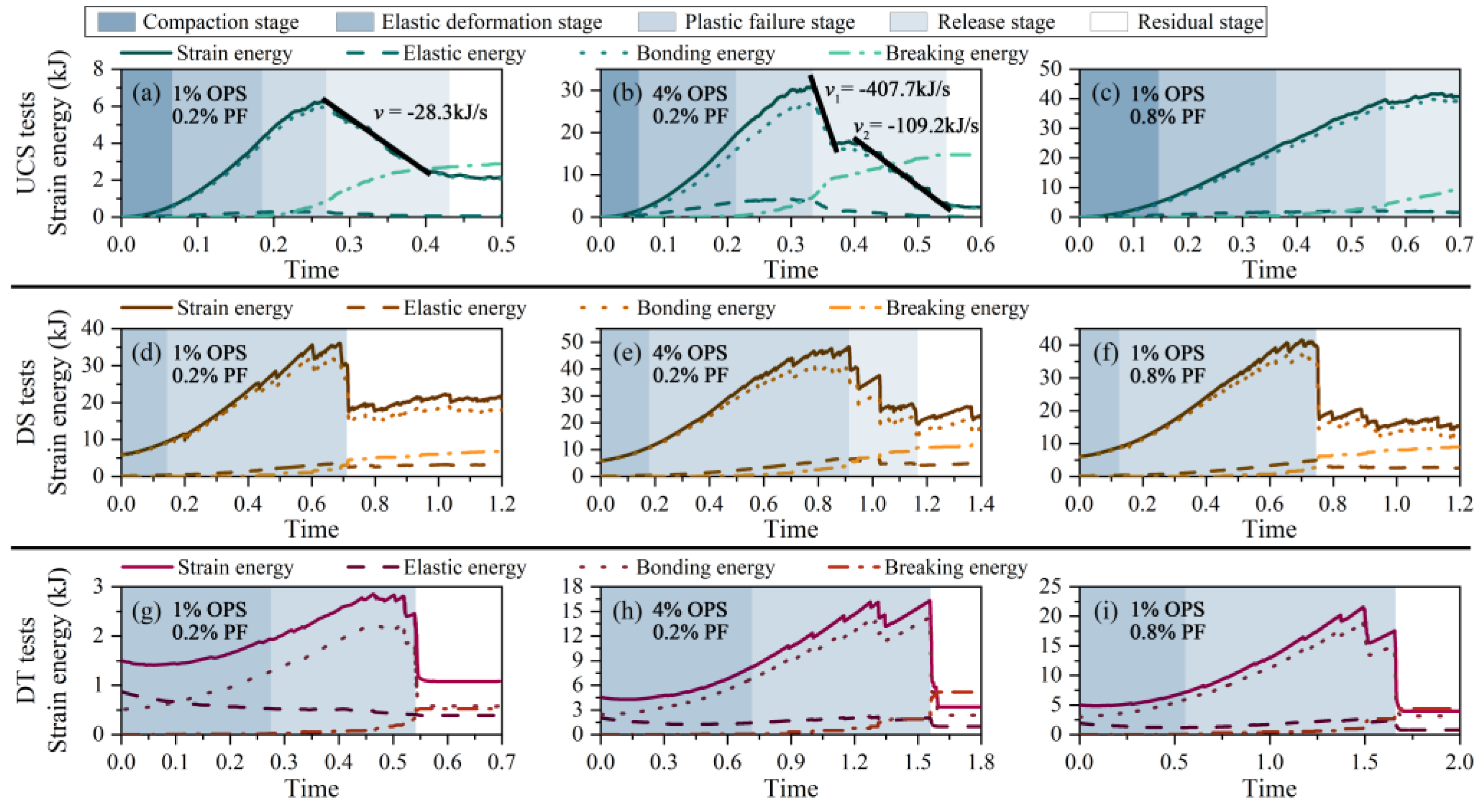

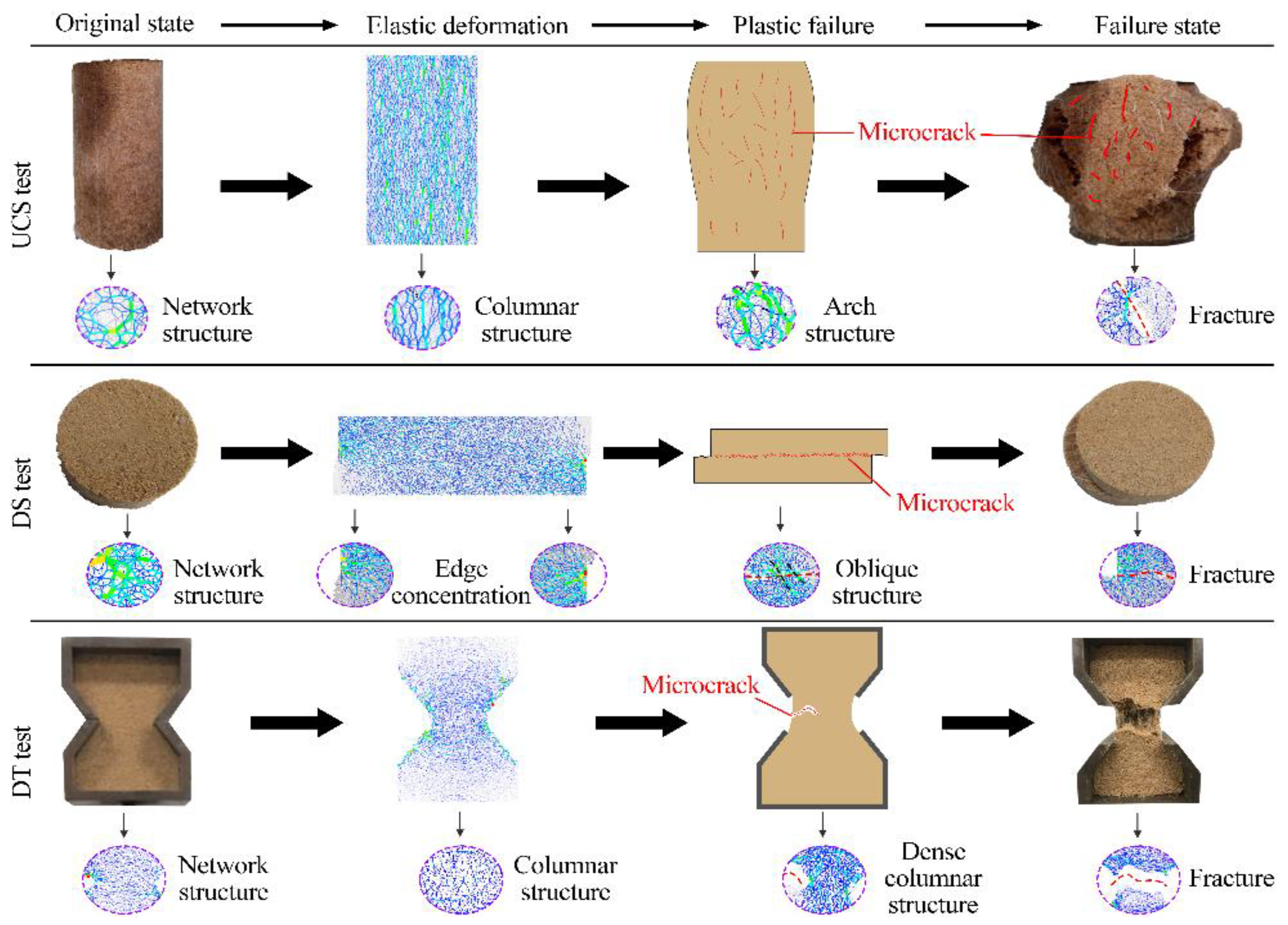
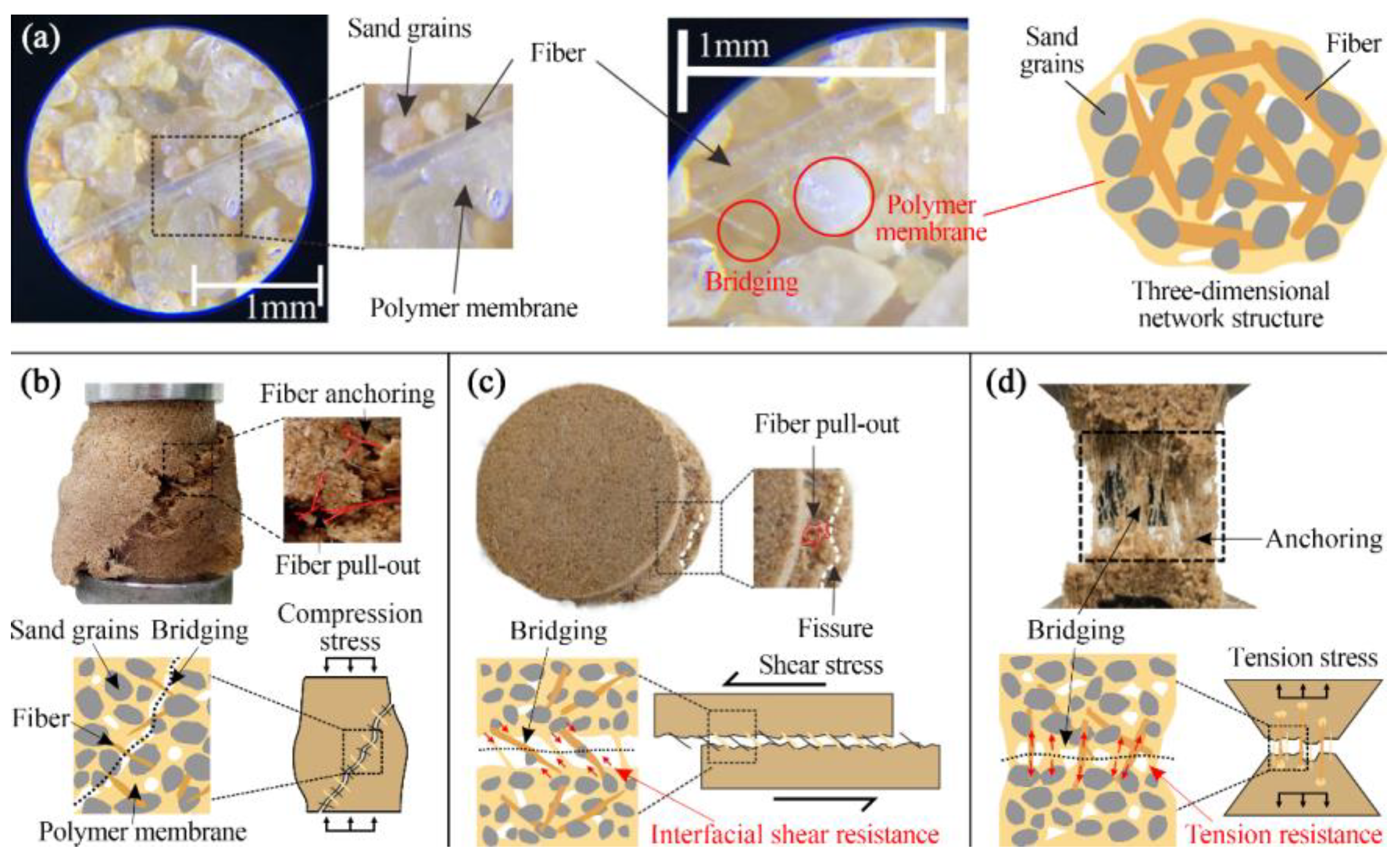
| Type | S.g | ρdmax (g/cm3) | ρdmin (g/cm3) | d10 (mm) | d30 (mm) | d60 (mm) | Cu | Cc | Category (USCS) |
|---|---|---|---|---|---|---|---|---|---|
| value | 2.66 | 1.7 | 1.32 | 0.12 | 0.22 | 0.36 | 3 | 1.12 | SP |
| Parameters | Values | Data |
|---|---|---|
| Particles | Diameter of sand (mm) | 0.07–2.0 |
| Density of sand (kg/m3) | 1.50 × 103 | |
| Initial porosity of sand | 0.10 | |
| Diameter of fiber (mm) | 0.04 | |
| Density of fiber (kg/m3) | 0.91 × 103 | |
| Coefficient of particle friction | 0.5 | |
| Damp | 0.7 | |
| Parallel bond | Stiffness ratio | 1.5 |
| Young’s and shear modulus (Pa) | 0.65–2.58 × 105 | |
| Bond effective modulus (Pa) | 0.4–2.0 × 105 | |
| Gap interval (mm) | 5.0 × 10−5 | |
| Cohesion (Pa) | 0.35–2.25 × 105 | |
| Tensile strength (Pa) | 0.70–4.50 × 105 | |
| Friction angle (°) | 16–26 | |
| Liner bond | Stiffness ratio | 1.5 |
| Young’s and shear modulus (Pa) | 1.0 × 109 |
Disclaimer/Publisher’s Note: The statements, opinions and data contained in all publications are solely those of the individual author(s) and contributor(s) and not of MDPI and/or the editor(s). MDPI and/or the editor(s) disclaim responsibility for any injury to people or property resulting from any ideas, methods, instructions or products referred to in the content. |
© 2023 by the authors. Licensee MDPI, Basel, Switzerland. This article is an open access article distributed under the terms and conditions of the Creative Commons Attribution (CC BY) license (https://creativecommons.org/licenses/by/4.0/).
Share and Cite
Zhang, R.; Huang, G.; Song, Z.; Zheng, J.; Wu, P.; Zhang, C.; Lu, Y.; Wang, Z.; Dai, C. Numerical Investigation of Mechanical Performance and Micro-Structure Failure of Polymer-Fiber Reinforced Sand. Polymers 2023, 15, 4528. https://doi.org/10.3390/polym15234528
Zhang R, Huang G, Song Z, Zheng J, Wu P, Zhang C, Lu Y, Wang Z, Dai C. Numerical Investigation of Mechanical Performance and Micro-Structure Failure of Polymer-Fiber Reinforced Sand. Polymers. 2023; 15(23):4528. https://doi.org/10.3390/polym15234528
Chicago/Turabian StyleZhang, Runqi, Guojiao Huang, Zezhuo Song, Jiaqiang Zheng, Peng Wu, Chenyang Zhang, Yipin Lu, Zhengjie Wang, and Chengjiang Dai. 2023. "Numerical Investigation of Mechanical Performance and Micro-Structure Failure of Polymer-Fiber Reinforced Sand" Polymers 15, no. 23: 4528. https://doi.org/10.3390/polym15234528






